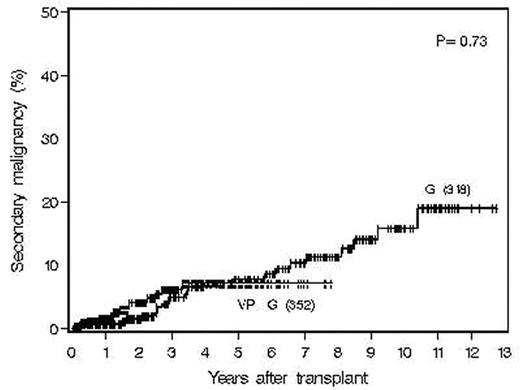Abstract
We compared the safety and effectiveness of high-dose etoposide followed by granulocyte colony-stimulating factor (G-CSF) to G-CSF alone for peripheral-blood progenitor cell (PBPC) mobilization regimen in patients with non-Hodgkin lymphoma (NHL) and Hodgkin lymphoma (HL) who underwent autotransplantation (ASCT). Primary end points were CD 34+ cell collection, post-priming hospitalization for neutropenic fever and incidence of secondary malignancy. Prior studies have demonstrated that high dose etoposide significantly improves the proportion of patients who collect sufficient PBPC’s for transplantation. From 1/1993 through 12/2005, 352 patients received etoposide (2g/m2) followed by G-CSF (10mcg/kg/day) and 318 who received G-CSF (10mcg/kg/day) alone underwent ASCT. Patients who had inadequate cell collection were excluded. Mean age of patients receiving etoposide and G-CSF was 49 years and G-CSF alone was 45 years (p<0.001). The two groups were otherwise similar with respect to bone marrow involvement, International Prognostic Index, number of prior chemotherapy regimens, prior radiation therapy and disease status at transplant. In the group receiving etoposide, 216 patients (61%) are alive with a median follow up of 34.9 months (range, 4.1–93.8). In the G-CSF group, 162 (51%) patients are alive with a median follow up of 85.5 months (range, 6.2–153.2). In the etoposide group, median total CD34+ cells collected were 9.14×106/kg with 41% of all patients having adequate (2×106 cells/kg) CD 34+ collection after 2 days of apheresis compared to a median CD34+ cells collected in the G-CSF group of 3.93×106/kg (range, 1.98–50.38) with only 16% patients having adequate collection after 2 days. Post-priming readmissions for neutropenic fever were required in 86 patients (24%) in the etoposide group, none of which were fatal, and 1 patient in the G-CSF alone group. Following transplantation, median length of stay, times to neutrophil engraftment and platelet recovery were similar in the two groups as were the incidence and causes of death within 100 days of transplantation. Secondary malignancies occurred in 14 patients (4%) in the etoposide group of whom 7 patients had hematological malignancies (MDS=4; AML = 2; ALL=1) and in 24 (7.5%) patients receiving G-CSF alone, with 14 patients having hematological malignancies (MDS=9; AML=3; CLL=1; HD=1). The estimated incidence of secondary malignancies at 5 years was 7.1% in the etoposide group and 7.8% in the G-CSF alone group as shown below:
There was no significant difference in the incidence of secondary malignancies (p=0.73) or in the incidence of relapse (p=0.5) or survival (p=0.15) between the two groups.
Conclusion: The present study shows that even when restricted to patients who collect adequate numbers of PBPCs, the addition of etoposide significantly improves the effectiveness of mobilization. This occurs at the cost of an increased incidence of neutropenic fever but with no mortalities. Following transplantation, there is no evidence of increased adverse effects due to addition of etoposide for priming, including on the incidence of secondary malignancies.
Author notes
Disclosure: No relevant conflicts of interest to declare.


This feature is available to Subscribers Only
Sign In or Create an Account Close Modal